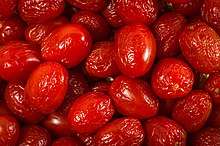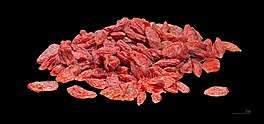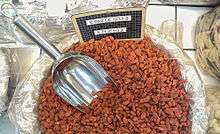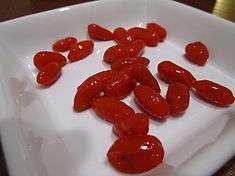Goji
_(1).jpg)
Goji, goji berry, or wolfberry, is the fruit of either Lycium barbarum or Lycium chinense, two closely related species of boxthorn in the nightshade family, Solanaceae.[1]
Both species are native to Asia,[1] and have been long used in traditional Asian cuisine. The fruits are similar but can be distinguished by small but significant differences in taste, sugar content, and content of the aminoacid betaine.[2]
The fruit has also been an ingredient in traditional Chinese, Korean, Vietnamese, and Japanese medicine, since at least the 3rd century CE.[2][3] The plant parts are called by the Latin names lycii fructus (fruit), herba lycii (leaves), etc., in modern official pharmacopeias.[4][5]
Since about 2000, goji berry and derived products became common in the West as health foods or alternative medicine remedies extending from exaggerated and unproven claims about their health benefits.[6][7]
Etymology and naming
The genus name Lycium was assigned by Linnaeus in 1753. The Latin name lycium is derived from the Greek word λυκιον (lykion), used by Pliny the Elder (23-79) and Pedanius Dioscorides (ca. 40-90) for a plant known as dyer's buckthorn, which was probably a Rhamnus species. The Greek word refers to the ancient region of Lycia (Λυκία) in Anatolia, where that plant grew.[8][9]
The common English name, "wolfberry",[10] has unknown origin. It may have arisen from the mistaken assumption that the Latin name Lycium was derived from Greek λύκος (lycos) meaning "wolf".[11][12]
| Goji | |||||||||||||||||||||||||||||||
| Chinese | 枸杞 | ||||||||||||||||||||||||||||||
|---|---|---|---|---|---|---|---|---|---|---|---|---|---|---|---|---|---|---|---|---|---|---|---|---|---|---|---|---|---|---|---|
| |||||||||||||||||||||||||||||||
| Gouji | |||||||||||||||||||||||||||||||
| Chinese | 枸檵 | ||||||||||||||||||||||||||||||
| |||||||||||||||||||||||||||||||
In the English-speaking world, the name "goji berry" has been used since around 2000.[13][14][15] The word "goji" is an approximation of the pronunciation of gǒu qǐ (pinyin for 枸杞), the name for the berry producing plant L. chinense in several Chinese dialects, including Hokkien and Shanghainese.[12][16]
In technical botanical nomenclature, L. barbarum is called matrimony vine while L. chinese is Chinese desert-thorn.[17]
Uses


Traditional Asian cuisine
Young wolfberry shoots and leaves are harvested commercially as a leaf vegetable.[18][19]
Health food

Since the early 21st century, the dried fruit has been marketed in the Western world as a health food, amidst scientifically unsupported claims regarding such benefits.[12][14][16][20][21][22] In the wake of those claims, dried and fresh goji berries were included in many snack foods and food supplements, such as granola bars,[23] yogurt, tea blends, fruit juices and juice concentrates, whole fruit purées, and dried pulp flour. There have been also commercial products of whole and ground wolfberry seeds, and seed oil.
Marketing controversies
Among the extreme claims used to market the product, often referred to as a "superfruit", is the unsupported story that a Chinese man named Li Qing Yuen, who was said to have consumed wolfberries daily, lived to the age of 256 years (1677–1933). This claim apparently originated in a 2003 booklet by Earl Mindell, who claimed also that goji had anti-cancer properties.[24] The booklet contained false and unverified claims.[6][12]
Such exaggerated claims about the health benefits of goji berry and derived products triggered strong reactions, including from government regulatory agencies. In 2006, the U.S. Food and Drug Administration (FDA) placed two goji juice distributors on notice with warning letters about unproven therapeutic benefits.[25][26] These statements were in violation of the United States Food, Drug and Cosmetic Act [21 USC/321 (g)(1)][27] because they "establish[ed] the product as a drug intended for use in the cure, mitigation, treatment, or prevention of disease" when wolfberries or juice have had no such scientific evaluation. Additionally stated by the FDA, the goji juice was "not generally recognized as safe and effective for the referenced conditions" and therefore must be treated as a "new drug" under Section 21(p) of the Act. New drugs may not be legally marketed in the United States without prior approval of the FDA.
In January 2007, marketing statements for a goji juice product were the subject of an investigative report by consumer advocacy program Marketplace produced by the Canadian television network, CBC.[6] In the interview, Earl Mindell (then working for direct-marketing company FreeLife International, Inc.) falsely claimed the Memorial Sloan-Kettering Cancer Center in New York had completed clinical studies showing that use of wolfberry juice would prevent 75% of human breast cancer cases.[6]
On May 29, 2009, a class action lawsuit was filed against FreeLife in the United States District Court of Arizona. This lawsuit alleged false claims, misrepresentations, false and deceptive advertising and other issues regarding FreeLife’s Himalayan Goji Juice, GoChi, and TaiSlim products. This lawsuit sought remedies for consumers who had purchased the products over years.[7][28] A settlement agreement was reached on April 28, 2010, where FreeLife took steps to ensure that its goji products were not marketed as "unheated" or "raw", and made a contribution to an educational organization.
As with many other novel "health" foods and supplements, the lack of clinical evidence and poor quality control in the manufacture of consumer products prevent goji from being clinically recommended or applied.[29]
Scientific research
Because of the numerous effects claimed by traditional medicine, there has been considerable basic research to investigate possible medicinal uses of substances contained in the fruit. The composition of the fruits, seeds, roots, and other parts have been analyzed in detail, and extracts are under study in vitro and in vivo.[29] However, no clinical effectiveness of such extracts has been confirmed as of 2018.[12][13][16]
Safety
Interaction with other drugs
In vitro testing suggests that unidentified wolfberry phytochemicals in goji tea may inhibit metabolism of other medications, such as those processed by the cytochrome P450 liver enzymes.[13] Such drugs include warfarin, or drugs for diabetes or hypertension.[13]
Pesticide and fungicide residues
Organochlorine pesticides are conventionally used in commercial wolfberry cultivation to mitigate infestation by insects. China's Green Food Standard, administered by the Chinese Ministry of Agriculture's China Green Food Development Center, does permit some amount of pesticide and herbicide use.[30][31][32] Agriculture in the Tibetan plateau (where many "Himalayan" or "Tibetan"-branded berries supposedly originate) conventionally uses fertilizers and pesticides, making organic claims for berries originating here dubious.[33]
Since the early 21st century, high levels of insecticide residues (including fenvalerate, cypermethrin, and acetamiprid) and fungicide residues (such as triadimenol and isoprothiolane), have been detected by the United States Food and Drug Administration in some imported wolfberries and wolfberry products of Chinese origin, leading to the seizure of these products.[34]
Cultivation and commercialization


Wolfberries are most often sold in dried form.
When ripe, the oblong, red berries are tender and must be picked carefully or shaken from the vine into trays to avoid spoiling. The fruits are preserved by drying them in full sun on open trays or by mechanical dehydration employing a progressively increasing series of heat exposure over 48 hours.[22]
China
China is the main supplier of wolfberry products in the world, with total exports generating US$120 million in 2004. This production derived from 82,000 hectares farmed nationwide, yielding 95,000 tons of wolfberries.[35]
The majority of commercially produced wolfberry (50,000 tons in 2013, accounting for 45% of China's total yield) comes from L. barbarum plantations in the Ningxia and Xinjiang in Northwestern China, totaling 200,000 acres as of 2005.[22]. The cutivation is centered in Zhongning County, Ningxia, where wolfberry plantations typically range between 40 and 400 hectares (100–1000 acres or 500–6000 mu) in area.
Ningxia goji has been cultivated along the fertile floodplains of the Yellow River for more than 700 years. They are sometimes described commercially as "red diamonds".[35][36] The region has developed an industrial association of growers, processors, marketers, and scholars of wolfberry cultivation to promote the berry's commercial and export potential.[37] Ningxia goji is the variety used by practitioners of traditional Chinese medicine.[37]
Wolfberries are celebrated each August in Ningxia with an annual festival coinciding with the berry harvest.[38] Originally held in Ningxia's capital, Yinchuan, the festival has been based since 2000 in Zhongning County.[38]
Besides Ningxia, commercial volumes of wolfberries grow in the Chinese regions of Inner Mongolia, Qinghai, Gansu, Shaanxi, Shanxi, and Hebei.
United Kingdom
Lycium barbarum had been introduced in the United Kingdom in the 1730s by The Duke of Argyll, but the plant was mostly used for hedges and decorative gardening.[39]
The UK Food Standards Agency (FSA) had initially placed goji berry in the Novel Foods list.[40] That classification would have required authorisation from the European Council and Parliament for marketing. However, on June 18, 2007, the FSA concluded that there was a significant history of consumption of the fruit before 1997, indicating its safety, and thus removed it from the list.[15]
Canada and United States
In the first decade of the 21st century, farmers in Canada and the United States began cultivating goji on a commercial scale to meet potential markets for fresh berries, juice, and processed products.[41][42]
See also
| Goji | |||||||||||||||
| Chinese | 枸杞 | ||||||||||||||
|---|---|---|---|---|---|---|---|---|---|---|---|---|---|---|---|
| |||||||||||||||
- Gouqi jiu
- List of culinary fruits
- List of dried foods
- Lycium barbarum
- Sea buckthorn – another plant that somewhat resembles Wolfberry
References
- 1 2 Flint, Harrison Leigh (1997). "Lycium barbarum". Landscape plants for eastern North America: exclusive of Florida and the immediate Gulf Coast. Chichester: John Wiley & Sons. p. 326. ISBN 978-0-471-59919-7.
- 1 2 Hye Won Lee, Young Hwa Kim, Yun Hee Kim, Gwan Ho Lee, and Mi Young Lee (2014): "Discrimination of Lycium chinense and Lycium barbarum by taste pattern and betaine analysis". International journal of clinical Experimental Medicine, volume 7, issue 8, pages 2053–2059. PMC 4161546 PMID 25232386
- ↑ Nobuo Kawahara, ed. (2011): "Comparative Studies on Pharmacopoeial Definitions, Requirements and Information for Crude Drugs among FHH Member Countries in 2007". Western Pacific Regional Forum for the Harmonization of Herbal Medicines (FHH). Online document, accessed on 2018-06-12.
- ↑ "Lycii fructus", European Pharmacopoea 9.3, page 4812
- ↑ Ray Upton et al., editors (2010): "Lycium chinense Mill, L. barbarum L., Lycium fruit, Lycii fructus". In American Herbal Pharmacopoeia Botanical Pharmacognosy: Microscopic Characterization Of Botanical Medicines, page 468. Published by CRC Press.
- 1 2 3 4 "Getting Juiced". CBC News. January 17, 2007. Archived from the original on 2007-02-02. Retrieved 2015-02-06.
- 1 2 United States District Court for the District of Arizona (May 29, 2009). "Class action lawsuit against FreeLife International, Inc" (PDF). Archived from the original (PDF) on August 1, 2010. Retrieved 2009-10-31.
- ↑ Austin, D. F. (2004). Florida Ethnobotany. CRC Press. p. 677. ISBN 9780849323324.
- ↑ Huxley, A., ed. (1992). New RHS Dictionary of Gardening. Macmillan ISBN 0-333-47494-5.
- ↑ "Scientific classification for Lycium barbarum L." Natural Resources Conservation Service. US Department of Agriculture. Retrieved 13 April 2013.
- ↑ Smal, Ernest (2012). Top 100 Exotic Food Plants. CRC Press. p. 249. Retrieved September 12, 2015.
- 1 2 3 4 5 Gross PM (2007). "Goji: what it is... and isn't". NewHope Network, Penton Media Inc.
- 1 2 3 4 NIH (January 2013). "Lycium". MedlinePlus. US National Institutes of Health. Retrieved 13 April 2013.
- 1 2 "Goji Berries" (PDF). UK Food Standards Agency, Novel Foods, Additives and Supplements Division. June 2007. Archived from the original (PDF) on 20 November 2012. Retrieved 13 April 2013.
- 1 2 Responses on goji berries reviewed, UK Food Standards Agency, June 2007
- 1 2 3 Dharmananda S (2007). "Lycium fruit: food and medicine". Institute for Traditional Medicine.
- ↑ "Classification for Kingdom Plantae Down to Genus Lycium L." US Department of Agriculture, Natural Resources Conservation Services. 2017. Retrieved 26 January 2017.
- ↑ Isabelle, M.; Lee, B.L.; Lim, M.T.; Koh, W.-P.; Huang, D.; Ong, C.N. (2010). "Antioxidant activity and profiles of common vegetables in Singapore". Food Chemistry. 120 (4): 993–1003. doi:10.1016/j.foodchem.2009.11.038.
- ↑ Dong, J.; Lu, D.; Wang, Y. (2009). "Analysis of flavonoids from leaves of cultivated Lycium barbarum L." Plant Foods for Human Nutrition. 64 (3): 199–204. doi:10.1007/s11130-009-0128-x.
- ↑ McNally A. Superfoods market set to double by 2011, NutraIngredients.com-Europe, October 8, 2007
- ↑ Runestad T. Functional Ingredients market overview, Functional Ingredients, October 2007 Archived 2007-10-13 at the Wayback Machine.
- 1 2 3 Fouch S, Hanson E. "Potential for saskatoon and goji berry production in the Great Lakes region" (PDF). Michigan State University. Archived from the original (PDF) on 14 November 2014. Retrieved 9 March 2014.
- ↑ Baltazar A (January 2010). "Raising the Bar (on Chocolate)". Nutraceuticals World. Rodman Media. Retrieved 13 April 2013.
- ↑ Earl Mindell and Rick Handel (2003), "Goji: The Himalyan Health Secret". Momentum Media, 58 pages. ISBN 978-0967285528
- ↑ US FDA Letter to Dynamic Health Laboratories, Inc.
- ↑ US FDA, Letter to Healthsuperstore.com
- ↑ "Federal Food, Drug, and Cosmetic Act (FD&C Act)".
- ↑ Class-Action Suit Filed against FreeLife and Earl Mindel
- 1 2 Potterat, O (2010). "Goji (Lycium barbarum and L. Chinense): Phytochemistry, pharmacology and safety in the perspective of traditional uses and recent popularity". Planta Medica. 76 (1): 7–19. doi:10.1055/s-0029-1186218. PMID 19844860.
- ↑ Pathbreaking Newsletter Promotes Development of Organic Sector in China Archived 2006-12-31 at the Wayback Machine. Lila Buckley. Worldwatch Institute. 28 February 2006.
- ↑ GAIN Report #CH1072. Dueling Standards for Organic Foods 2001 Ralph Bean and Xiang Qing. USDA Global Agriculture Information Network Foreign Agricultural Service. 12 Dec 2001.
- ↑ The Movement Toward Organic Herb Cultivation in China Subhuti Dharmananda. Institute for Traditional Medicine. January 2004.
- ↑ "Archived copy". Archived from the original on 2012-10-19. Retrieved 2012-11-01. Staff Reporter. The commercial legend of goji. Selling a Chinese crop under the Tibetan flag. TibetInfoNet, July 29, 2007.
- ↑ "IMPORT ALERT IA9908". fda.gov. Archived from the original on 6 January 2008.
- 1 2 "Wolfberry festival to be held in Ningxia". China Daily. 2004-07-19. Retrieved 2015-02-05.
- ↑ "Harvest and trade for Chinese Wolfberry in Ningxia". China Daily USA. 28 October 2013. Retrieved 2 March 2015.
- 1 2 "China's First Provincial-level Wolfberry Association Established". People's Daily - English. 19 August 2001. Retrieved 2 March 2015.
- 1 2 Xinhua News Agency, Opening ceremonies of Ningxia wolfberry festival, August 3, 2005.
- ↑ "Goji". Germplasm Resources Information Network (GRIN). Agricultural Research Service (ARS), United States Department of Agriculture (USDA).
- ↑ The Novel Foods and Novel Food Ingredients Regulations 1997
- ↑ Boutin, N (July 30, 2008). "Fairground family first to gamble on gojis". Woodstock Sentinel Review. Sun Media. Retrieved 14 April 2013.
- ↑ Karp, D (August 5, 2009). "Goji taunts North American farmers". Los Angeles Times - Food. LA Times. Retrieved 14 April 2013.
External links
| Look up wolfberry or 枸杞子 in Wiktionary, the free dictionary. |
| Wikimedia Commons has media related to Lycium barbarum. |